|
This page contains a short description of NCIPC publications. Some of these publications are out of print and available only in electronic format. Sort the table by clicking on the column header: |
| Publication | Description | Division/Topic | Year |
|---|---|---|---|
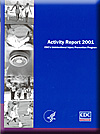 Activity Report 2001: CDC’s Unintentional Injury Prevention
Program Activity Report 2001: CDC’s Unintentional Injury Prevention
Program |
The Activity Report 2001: CDC's Unintentional Injury Prevention Program highlights the DUIP's research on Unintentional injuries are a leading cause of death for all Americans, regardless of age, race, gender, or economic status. The Division of Unintentional Injury and Prevention (DUIP), part of CDC’s Injury Center, has produced a report detailing their achievements to prevent such injuries and to minimize their consequences. The Activity Report 2001: CDC’s Unintentional Injury Prevention Program highlights The Division of Unintentional Injury and Prevention's (DUIP) research and programmatic accomplishments in motor vehicle and home and recreation injury areas during 2000-2001. | Unintentional Injury Prevention | 2003 |
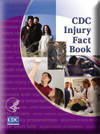 CDC Injury Fact Book CDC Injury Fact Book |
The CDC Injury Fact Book offers a wealth of injury data and descriptions of CDC research and prevention programs for a full spectrum of injuries—from those related to acute injury care or alcohol use to those resulting from youth violence. | All Injury Divisions | 2006 |
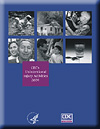 Activity Report
2004: CDC’s Unintentional Injury Prevention Program Activity Report
2004: CDC’s Unintentional Injury Prevention Program
|
Unintentional injuries are a leading cause of death for all Americans, regardless of age, race, gender, or economic status. The Division of Unintentional Injury and Prevention (DUIP), part of CDC’s Injury Center, has produced a report detailing their achievements to prevent such injuries and to minimize their consequences. CDC’s Unintentional Injury Activities 2004 highlights the agency’s research and programmatic accomplishments during 2002-2004 in the areas of motor vehicle and home and recreation injury. | Unintentional Injury Prevention | 2005 |
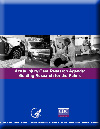 CDC Acute Injury Care Research
Agenda: Guiding Research for the Future CDC Acute Injury Care Research
Agenda: Guiding Research for the Future
|
In 2003, the National Center for Injury Prevention and Control—CDC’s Injury Center—identified gaps in the area of acute injury care and updated the CDC Injury Research Agenda (2002) to clearly state CDC’s highest priorities for acute care research. That same year, the Injury Center began to update its Research Agenda by focusing on research that will ultimately make a difference in improving acute injury care systems and the care individuals receive when they are injured. After a two-year process of engaging injury care and public health experts, the revised Acute Injury Care Research Agenda was released at the National Injury Prevention and Control Conference in Denver on May 11, 2005. | Injury Response | 2005 |
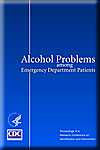 Alcohol
Problems Among Emergency Department Patients: Proceedings of a
Research Conference on Identification and Intervention Alcohol
Problems Among Emergency Department Patients: Proceedings of a
Research Conference on Identification and Intervention |
This comprehensive report presents proceedings of a jointly sponsored conference convened on March 1921, 2001. The conference brought together researchers, practitioners, and other stakeholders from around the country to review current knowledge about alcohol problems among emergency department (ED) patients and about ED-based screening and intervention method. | Injury Response | 2002 |
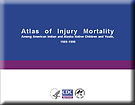 Atlas of Injury Mortality Among
American Indian and Alaska Native Children and Youth Atlas of Injury Mortality Among
American Indian and Alaska Native Children and Youth |
During 1989-1998, injuries caused the deaths of 3,718 Native American children, aged 0-19 years, residing in the Indian Health Service areas. Injury is the leading cause of death for all American children, but poses a particular threat to Native American children. To reduce this disparity, increased efforts should be made to protect Native American children and to narrow the gap with other children in America. | Unintentional Injury Prevention | 2005 |
 |
This fact sheet provides up-to-date data and statistics on child maltreatment. | Child Maltreatment | 2006 |
 Best Practices of Youth Violence Prevention: A Sourcebook For Community Action Best Practices of Youth Violence Prevention: A Sourcebook For Community Action
|
This publication examines the effectiveness of specific violence prevention practices in four key areas: parents and families; home visiting; social and conflict resolution skills; and mentoring. It also documents the science behind each best practice and offers a comprehensive directory of resources for more information about programs that have used these practices. English or Spanish | Youth Violence | 2002 |
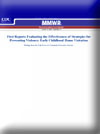 First Reports Evaluating the Effectiveness of Strategies for
Preventing Violence: Firearm Laws First Reports Evaluating the Effectiveness of Strategies for
Preventing Violence: Firearm Laws |
The Task Force on Community Preventive Services, an independent nonfederal task force, conducted a systematic review of scientific evidence regarding the effectiveness of firearm laws in preventing violence. This report summarizes the findings and recommendations. | Youth Violence | 2003 |
 Measuring Violence-Related Attitudes, Behaviors, and
Influences Among Youths: A Compendium of Assessment Tools -
Second Edition Measuring Violence-Related Attitudes, Behaviors, and
Influences Among Youths: A Compendium of Assessment Tools -
Second Edition |
This compendium provides researchers and prevention specialists with a set of tools to assess violence-related beliefs, behaviors, and influences, as well as to evaluate programs to prevent youth violence. | Youth Violence | 2005 |
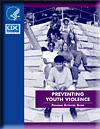 Preventing Youth Violence: Program Activities Guide Preventing Youth Violence: Program Activities Guide |
This document describes CDC’s public health activities and research to prevent youth violence. The guide outlines five categories of activities which are key to CDC’s prevention work: monitoring and researching the problem, developing and evaluating prevention strategies, supporting and enhancing prevention programs, providing prevention resources, and encouraging research and development. | Youth Violence | 2001 |
 Prácticas
Óptimas para la Prevención de la Violencia Juvenil: Libro
de Referencia
para la Acción Comunitaria Prácticas
Óptimas para la Prevención de la Violencia Juvenil: Libro
de Referencia
para la Acción Comunitaria |
permite un mejor entendimiento acerca de las prácticas que hacen que funcionen los programas de prevención. Es el primer documento en su tipo que analiza la efectividad de prácticas específicas en cuatro áreas principales: padres y la familia, visitas en el hogar, sociocognoscitiva y de padrinazgo. | Violence Prevention | 2002 |
 Bibliography
of Behavioral Science Research in Unintentional Injury Prevention Bibliography
of Behavioral Science Research in Unintentional Injury Prevention |
Includes more than 900 citations of journal articles, book chapters, government reports, and other publications. Designed as a tool for researchers, practitioners and students, this bibliography documents the contributions of behavioral and social sciences to unintentional injury prevention and control from 1980–2003. The CD-Rom includes the complete bibliography in two formats: (1) alphabetical by author; and (2) by injury topic. Citations are also indexed by keyword. | Unintentional Injury Prevention | 2004 |
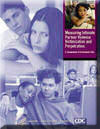 Measuring
Intimate Partner Violence Measuring
Intimate Partner Violence Victimization and Perpetration: A Compendium of Assessment Tools |
This compendium provides researchers and prevention specialists with a set of assessment tools with demonstrated reliability and validity for measuring the self-reported incidence and prevalence of Intimate Partner Violence victimization and perpetration. | Intimate Partner Violence | 2006 |
 Injury
Surveillance Training Manual Injury
Surveillance Training Manual
|
The Injury Surveillance Training Manual is designed primarily for professionals who develop or operate surveillance systems and conduct prevention activities in less-resourced countries. It describes the steps needed to establish and maintain an injury surveillance system; provides information on designing and monitoring prevention activities; and offers guidance for making informed decisions about injury prevention. The curriculum emphasizes basic epidemiological skills needed to conduct surveillance and prevention activities; participation by different sectors and institutions in injury prevention efforts; and injury surveillance and prevention activities at the local level. | Violence Prevention | 2005 |
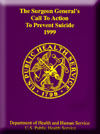 National Strategy for Suicide Prevention National Strategy for Suicide Prevention |
The National Strategy for Suicide Prevention represents the combined work of advocates, clinicians, researchers and survivors around the nation. It lays out a framework for action to prevent suicide and guides development of an array of services and programs that must be developed. It is designed to be a catalyst for social change with the power to transform attitudes, policies, and services. |
(Suicide), Violence Prevention |
2001 |
 CDC
Injury Research Agenda CDC
Injury Research Agenda |
The CDC Injury Research Agenda was developed with extensive input from its academic research centers, national nonprofit organizations, and other federal agencies with a stake in injury prevention.. This blueprint to prevent injuries and their resulting disabilities, deaths, and costs will guide research in seven key areas of injury prevention and control. The agenda identifies CDC’s highest priorities for each area—those research issues that CDC must address to fulfill its public health responsibilities. This publication is currently available only in HTML format; it will be available from the publications order form and in PDF format soon. | All Injury Divisions | 2002 |
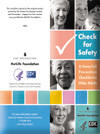 Check for Safety: A Home Fall Prevention Checklist for Older Adults Check for Safety: A Home Fall Prevention Checklist for Older Adults |
Falls are often due to hazards that are easy to overlook but easy to fix. This checklist will help you find and fix those hazards in your home. The checklist asks about hazards in each room of your home. For each hazard, the checklist tells you how to fix the problem. At the end of the checklist, you will find other tips for preventing falls. | Unintentional Injury Prevention | 2006 |
 Cost of Injury in the United States: A Report to
Congress Cost of Injury in the United States: A Report to
Congress |
Published in 1989, this report has proved to be a landmark publication articulating the need to address injury as a public health problem. This volume examines the economic impact resulting from the failure to deal with injury as a major threat to public health. The report identifies, for the first time, the magnitude of the economic effect of injury on the US in statistical and human terms through reliable dollar estimates and compelling case studies. The report also identifies public health efforts that have succeeded in reducing the impact and burden of injury on Americans. | All Injury Divisions | 1989 |
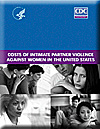 Costs
of Intimate Partner Violence Against Women in the United States Costs
of Intimate Partner Violence Against Women in the United States |
Congress funded the CDC to conduct a study to obtain national estimates of the occurrence of IPV-related injuries, to estimate their costs to the health care system, and to recommend strategies to prevent IPV and its consequences. This report describes findings from the study and identifies future research needs. | Intimate Partner Violence | 2003 |
 CDCynergy: Violence Prevention Edition CDCynergy: Violence Prevention Edition |
CDCynergy is a multimedia CD-ROM used for planning, managing, and evaluating public health communication programs. This edition of CDCynergy is ideal for those interested in developing prevention programs on the issues of child maltreatment, intimate partner violence, sexual violence, and youth violence. | General Violence Prevention | 2006 |
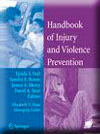 Handbook of Injury and Violence Prevention Handbook of Injury and Violence Prevention |
This comprehensive manual details injury and violence interventions that have proven to work effectively with vulnerable populations across all stages of life. It benefits practitioners who manage, implement, or evaluate injury or violence prevention programs; policymakers who influence injury or violence prevention through legislation and other policies; university faculty who teach coursework in injury and violence prevention; and graduate students preparing to work in or with injury or violence prevention programs. | General Violence Prevention | 2006 |
 Data Elements for Emergency Department Systems Data Elements for Emergency Department Systems |
NCIPC is coordinating a national effort to develop uniform specifications for data entered in emergency department (ED) patient records. The initial product is Data Elements for Emergency Department Systems, Release 1.0. | Injury Response | 1997 |
 Demonstrating Your Program's Worth:
A Primer on Evaluation for
Programs to Prevent Unintentional Injury Demonstrating Your Program's Worth:
A Primer on Evaluation for
Programs to Prevent Unintentional Injury |
This book shows program managers how to demonstrate the value of their work to the public, to their peers, to funding agencies, and to the people they serve. Our purpose is to show that managers and staff need not be apprehensive about what evaluation will cost or what it will show. | Unintentional Injury Prevention | 2000 |
 Efforts to Increase Smoke
Detector Use in U.S. Households: An Inventory of Programs Efforts to Increase Smoke
Detector Use in U.S. Households: An Inventory of Programs |
Each year in the United States, thousands of people die or are severely injured by fires and burns. One of the most effective ways to prevent deaths and injuries from fires is to install and maintain smoke detectors in households. As part of this effort, CDC's Injury Center conducted a nationwide survey in 1994 to identify the various strategies being used to increase the use of smoke detectors in homes. This publication features the descriptions of 49 programs from 33 states as well as two national programs. | Unintentional Injury Prevention | 1996 |
 Emergency
Department Services for Patients with Alcohol Problems: Research
Directions Emergency
Department Services for Patients with Alcohol Problems: Research
Directions |
This report summarizes recommendations on research directions developed from the conference "Alcohol Problems among Emergency Department Patients: Research on Identification and Intervention." The conference was developed in order to evaluate the existing state-of-the-art research on emergency department interventions for alcohol problems and offer further recommendations for research. | Injury Response | 2003 |
 Exposure to and compliance with pediatric injury prevention counseling--United States, 1994 Exposure to and compliance with pediatric injury prevention counseling--United States, 1994 |
Because injuries are the leading cause of death in children, injury prevention counseling is recommended as part of routine pediatric care. Increasing such counseling is a national health objective. Estimating the proportion of US children who receive such counseling and assessing their compliance with safety recommendations may help improve counseling efforts. | Unintentional Injury Prevention | 1998 |
 Facts about Concussion and Brain Injury and Where to Get Help Facts about Concussion and Brain Injury and Where to Get Help |
A blow or jolt to the head can cause a type of mild brain injury called a concussion. This brochure explains what can happen after a concussion, how to get better, and where to go for more information and help when needed. | Injury Response | 1999 |
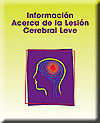 Información
Acerca de la Lesión Cerebral Leve Información
Acerca de la Lesión Cerebral Leve |
Facts About Concussion and Brain Injury: Where to Get Help ya fue traducida al español. Este folleto de 18 páginas está escrito para las personas con lesiones en el cerebro y sus familiares o quienes están encargados de cuidar su salud. El folleto ofrece información sobre las lesiones del cerebro, sus síntomas, consejos para sanar, y otros recursos. El folleto también destaca una línea telefónica gratuita de ayuda, ofrecida por la Asociación Americana de Lesiones del Cerebro en la cual las personas interesadas pueden obtener información y recursos adicionales. Miembros de la comunidad hispana, compuesta por una gran variedad de personas de diversos orígenes étnicos y raciales, participaron en el desarrollo, diseño y traducción de este folleto. | Injury Response | 2002 |
 First Reports Evaluating the Effectiveness of Strategies for Preventing Violence: Early Childhood Home Visitation First Reports Evaluating the Effectiveness of Strategies for Preventing Violence: Early Childhood Home Visitation
|
The Task Force on Community Preventive Services, an independent nonfederal task force, conducted a systematic review of scientific evidence regarding the effectiveness of home visiting programs in preventing violence. This report summarizes the findings and recommendations. | Child Maltreatment, Violence Prevention | 2003 |
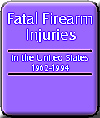 Fatal Firearm Injuries, 1962-1994 Fatal Firearm Injuries, 1962-1994 |
This report reviews the descriptive epidemiology of firearm-related mortality in the United States from 1962-1994. The patterns of overall firearm-related mortality and of homicide, suicide, unintentional death, deaths occurring during legal intervention, and deaths of undetermined intent are examined by race, sex, and age group. | Unintentional Injury Prevention | 1997 |
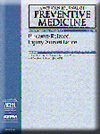 Firearm-Related Injury Surveillance, 1998 Firearm-Related Injury Surveillance, 1998 |
The articles in this volume report on progress that has been made in the surveillance of firearm-related injuries. There are several papers that provide a background to help understand the need for firearm-related injury surveillance. The remaining articles describe state-based firearm-related injury surveillance programs, providing a rich cache of practical lessons for successfully implementing firearm-related injury surveillance. | Unintentional Injury Prevention | 1998 |
 Framework for Presenting Nature of Injury Data Framework for Presenting Nature of Injury Data |
The Barell Injury Diagnosis Matrix: Classification by Region of Body and Nature of Injury | Statistical Programming | 2002 |
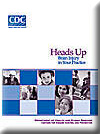 Heads
Up: Brain Injury in Your Practice Heads
Up: Brain Injury in Your Practice |
At least 1.4 million people sustain traumatic brain injuries in this country every year. Of those, approximately 1.1 million, or 75 percent, sustain a mild traumatic brain injury (MTBI). Yet, many are not hospitalized or receive no medical care at all. The CDC, working with a number of partners, has developed a new physician tool kit to improve clinical diagnosis and management of MTBI. Physicians can play a key role in helping to reduce the occurrence of MTBI by educating patients and the community about risks and injury prevention. | Injury Response | 2003 |
|
|
Concussions can happen to any athlete—male or female—in any sport. Coaches, athletic directors, and trainers play a key role in helping to prevent, recognize, and manage concussion among their athletes. Therefore, CDC, with the support of multiple partners and experts, has developed a tool kit for coaches titled, Heads Up: Concussion in High School Sports. This kit contains practical, easy-to-use information including a video and DVD, a wallet card and clip board sticker, posters, fact sheets, and a CD-ROM. | Injury Response | 2005 |
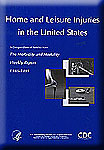 Home and Leisure Injuries in the United States Home and Leisure Injuries in the United States |
This compendium contains all of the MMWR articles concerning home and leisure injuries published from 1985 through 1995; a summary public health message precedes each article. The public health approach to preventing home and leisure injuries represented in this compilation covers areas related to surveillance, risk factors, and interventions. | Unintentional Injury Prevention | 1996 |
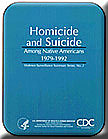 Homicide and Suicide Among Native Americans, 1979-1992 Homicide and Suicide Among Native Americans, 1979-1992 |
The information in this report should be useful to public health practitioners, researchers, and policy makers in addressing the problem of homicide and suicide among Native Americans. From 1979-1992, 4,718 American Indians and Alaskan Natives (Native Americans) who resided on or near reservations died from violence--2,324 from homicides and 2,394 from suicide. | Violence Prevention | 1996 |
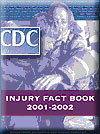 Injury Fact Book 2001–2002 Injury Fact Book 2001–2002 |
CDC's National Center for Injury Prevention and Control is pleased to bring you a comprehensive look at the injury problem in America and efforts underway to reduce it. The Fact Book offers a wealth of injury data and descriptions of CDC research and prevention programs for a full spectrum of injuries—from those related to alcohol use to those resulting from youth violence. | All Injury Divisions | 2001 |
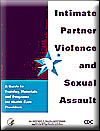 Intimate Partner Violence and Sexual Assault: A Guide to Training Materials and Programs for Health Care Providers Intimate Partner Violence and Sexual Assault: A Guide to Training Materials and Programs for Health Care Providers |
This guide helps health care providers find appropriate group-training or self-training materials related to IPV and sexual assault. | Intimate Partner Violence | 1998 |
 Intimate Partner Violence Surveillance: Uniform Definitions and Recommended Data Elements Intimate Partner Violence Surveillance: Uniform Definitions and Recommended Data Elements |
This report is intended for individuals and organizations interested in gathering surveillance data on IPV. The document is intended to promote and improve consistency of IPV surveillance. If the recommended data elements are uniformly recorded and the data made available to numerous users, then better estimates of the incidence and prevalence of IPV can be obtained. | Intimate Partner Violence | 1999 |
 Inventory of Federal Data Systems in the United States Inventory of Federal Data Systems in the United States |
This is an inventory of federal data systems that provide national data on injuries in the United States. We have identified 31 data systems that provide data useful for injury surveillance, research and prevention activities. This report provides a brief summary of each system, including how to access the data, data collection methods, data sources, and types of data obtained. | Injury Response | 1996 |
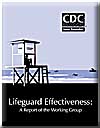 Lifeguard Effectiveness: A Report of the Working Group Lifeguard Effectiveness: A Report of the Working Group |
This report, published in October 2001 by CDC’s Injury Center, assesses lifeguards as a strategy for preventing drowning and water-related injuries. The product of an expert meeting and a review of data from the United States Lifeguard Association (USLA) and other sources, the report will help communities, local government officials, and owners of private water recreational areas make informed decisions about whether to begin, retain, or discontinue lifeguarding services. | Injury Response | 2001 |
 Measuring Violence-Related Attitudes, Beliefs, and Behaviors Among Youths: A Compendium of Assessment Tools Measuring Violence-Related Attitudes, Beliefs, and Behaviors Among Youths: A Compendium of Assessment Tools |
This compendium provides researches and prevention specialists with a set of tools to evaluate programs to prevent youth violence. Most of the measures in this compendium are intended for use with youths between 11 and 20 years, to assess factors such as attitudes towards violence, aggressive behavior, conflict resolution strategies, self-esteem, self-efficacy, and exposure to violence. | Violence Prevention | 2005 |
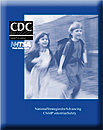 National Strategies for Advancing Child Pedestrian Safety National Strategies for Advancing Child Pedestrian Safety
|
This publication offers ideas for encouraging children to explore their environments by walking while reducing their risk of pedestrian injury. | Unintentional Injury Prevention | 2001 |
 National
Violent Death Reporting System Implementation Manual National
Violent Death Reporting System Implementation Manual |
There is a lack of basic information about the characteristics of violent deaths at the local, state, and national levels. CDC has developed a National Violent Death Reporting System (NVDRS) Implementation Manual to promote the development of a uniform violent death reporting system. Data from this system can be compared across states and localities and will help practitioners and policy makers design and evaluate local, regional, and national prevention programs and to make informed decisions about violence prevention. | General Violence Prevention | 2003 |
 National
Violent Death Reporting System Coding Manual National
Violent Death Reporting System Coding Manual |
The NVDRS Coding Manual is a reference document to be used by state health departments for defining cases, entering data, and checking data once it is entered. It contains information about individual variables and the way the data are structured. | General Violence Prevention | 2003 |
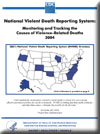 National Violent Death Reporting System: Monitoring and Tracking the Causes of Violence-Related Deaths 2004 National Violent Death Reporting System: Monitoring and Tracking the Causes of Violence-Related Deaths 2004
|
The National Violent Death Reporting System (NVDRS) collects data on violent deaths from death certificates, police reports, medical examiner and coroner reports, and crime laboratories. Individually, these sources offer fragmented data that explain violence in a narrow context. Together, these sources provide the who, what, when, where, why, and how of violent incidents and should offer insight into the optimal points for community and programmatic intervention. | General Violence Prevention | 2004 |
 The World Report on Violence and Health The World Report on Violence and Health |
This report is the first comprehensive review of violence on a global scale. It defines the various types of violence, explains whom it affects, and discusses prevention strategies. The publication is a joint effort of The World Health Organization and CDC. | General Violence Prevention | 2002 |
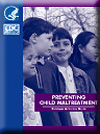 Preventing Child Maltreatment: Program Activities Guide Preventing Child Maltreatment: Program Activities Guide |
This document describes CDC’s public health activities and research to prevent child abuse and neglect. The guide outlines four categories of activities which are key to CDC’s prevention work: monitoring and researching the problem, developing and evaluating prevention strategies, supporting and enhancing prevention programs, and encouraging research and development. | Child Maltreatment | 2002 |
 Therapeutic Foster Care for the Prevention of Violence Therapeutic Foster Care for the Prevention of Violence |
The Task Force on Community Preventive Services, an independent nonfederal task force, conducted a systematic review of scientific evidence regarding the effectiveness of therapeutic foster care in preventing violence. This report summarizes the findings and recommendations. | Child Maltreatment | 2003 |
 Understanding Child Maltreatment Fact Sheet Understanding Child Maltreatment Fact Sheet
|
This 2-page fact sheet provides basic information on child abuse and neglect. It is intended for the general public | Child Maltreatment | 2006 |
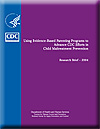 Using Evidence-Based Parenting Programs to Advance CDC Efforts in Child Maltreatment Prevention—Research Brief 2004 Using Evidence-Based Parenting Programs to Advance CDC Efforts in Child Maltreatment Prevention—Research Brief 2004 |
CDC has launched several prevention initiatives aimed at encouraging and promoting positive parent-child interactions. These initiatives are summarized in this publication. | Child Maltreatment | 2004 |
 Understanding Teen Dating Abuse Fact Sheet Understanding Teen Dating Abuse Fact Sheet
|
This 2-page fact sheet provides basic information on teen dating abuse. It is intended for the general public. | Intimate Partner Violence | 2006 |
 Preventing
Suicide: Program Activities Guide Preventing
Suicide: Program Activities Guide |
This document describes CDC’s public health activities and research to prevent suicide and suicidal behavior. The guide outlines four categories of activities which are key to CDC’s prevention work: monitoring and researching the problem, supporting and enhancing prevention programs, providing prevention resources, and encouraging research and development. |
Suicide |
2005 |
 Recent Trends in Violence-Related Behaviors Among High School Students in the United States
Abstract Recent Trends in Violence-Related Behaviors Among High School Students in the United States
Abstract |
Violence-related behaviors such as fighting and weapon carrying are associated with serious physical and psychosocial consequences for adolescents. The objective of this study was to measure trends in nonfatal violent behaviors among adolescents in the United States between 1991 and 1997. | Violence Prevention | 1999 |
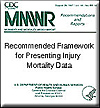 Recommended Framework for Presenting Injury Mortality Data Recommended Framework for Presenting Injury Mortality Data |
This report provides a framework for the uniform tabulation and analysis of injury mortality data classified by the Ninth Revision of the International Classification of Diseases (ICD-9) (a subsequent report will address the application of this framework to injury morbidity data). | Statistical Programming | 1997 |
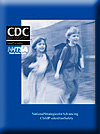 Reducing Childhood Pedestrian
Injuries: Proceedings of a Multidisciplinary Conference Reducing Childhood Pedestrian
Injuries: Proceedings of a Multidisciplinary Conference
|
These proceedings served as the basis for the National Strategies for Advancing Child Pedestrian Safety. | Unintentional Injury Prevention | 2002 |
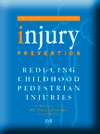 Reducing
Childhood Pedestrian Injuries: Summary of a Multidisciplinary
Conference Reducing
Childhood Pedestrian Injuries: Summary of a Multidisciplinary
Conference |
Released
in June 2002, this special supplement of Injury Prevention
includes recommendations from the National
Strategies for Advancing Child Pedestrian Safety as well an
executive summary of the multidisciplinary conference held on the
issue. |
Unintentional Injury Prevention | 2002 |
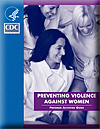 Preventing
Violence
Against Women: Program Activities Guide Preventing
Violence
Against Women: Program Activities Guide |
This document describes CDC’s public health activities and research to prevent violence against women. The guide outlines five categories of activities which are key to CDC’s prevention work: tracking the problem, developing and evaluating prevention strategies, supporting and enhancing prevention programs, providing prevention resources, and encouraging research and development. | Sexual Violence | 2005 |
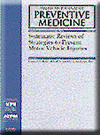 Reducing
Injuries to Motor Vehicle Occupants: Reducing
Injuries to Motor Vehicle Occupants: |
Systematic Reviews of Evidence,
Recommendations from the Task Force on Community Preventive Services, and Expert
Commentary This special supplement of the American Journal of Preventive Medicine (AJPM) contains systematic reviews and recommendations regarding 13 community-based interventions to reduce motor vehicle-related injuries and deaths. The publication highlights results from systematic reviews of scientific literature on interventions to decrease alcohol-impaired driving, increase the use of child safety seats, and increase use of safety belts. The Task Force on Community Preventive Services, an independent, nonfederal panel of community health experts, issued their recommendations, based on demonstrated evidence of effectiveness from the reviews coordinated by CDC. |
Unintentional Injury Prevention | 2001 |
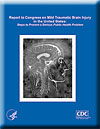 Report to Congress on Mild Traumatic Brain Injury in the United
States: Steps to Prevent a Serious Public Health Problem Report to Congress on Mild Traumatic Brain Injury in the United
States: Steps to Prevent a Serious Public Health Problem |
CDC formed the Mild Traumatic Brain Injury (MTBI) Work Group, composed of experts in the field of brain injury, to determine appropriate and feasible methods for assessing the incidence and prevalence of MTBI in the United States. This report presents the significant findings and recommendations of the MTBI Work Group, which are the product of numerous discussions and a thorough review of the scientific literature. It describes the public health significance of MTBI and recommends how to better measure the magnitude of the problem in this country. | Injury Response | 2003 |
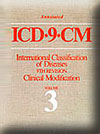 Revised Framework of E-code Groupings Revised Framework of E-code Groupings
|
This is a direct link to a zipped (276K compressed) Excel '97 spreadsheet-based listing of ICD-9-CM 'injury' E-codes and their associated mechanism and intent groups (matrix) as defined by the Centers for Disease Control (CDC). |
Statistical Programming | 1998 |
 School-Associated
Violent Deaths in the United States, 1994-1999 School-Associated
Violent Deaths in the United States, 1994-1999 |
This article describes trends and features of school-associated violent deaths in the United States between 1994 and 1999. | Youth Violence | 2001 |
 School-Associated
Violent Deaths in the United States, 1992-1994 School-Associated
Violent Deaths in the United States, 1992-1994 |
This article describes trends and features of school-associated violent deaths in the United States between 1992 and 1994. | Youth Violence | 1996 |
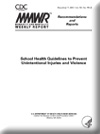 School Health Guidelines to Prevent Unintentional Injuries
and Violence School Health Guidelines to Prevent Unintentional Injuries
and Violence |
These guidelines were designed to help education agencies and schools promote safety and make schools safe places for students to learn. | Youth Violence | 2001 |
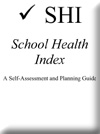 School Health Index School Health Index |
The School Health Index is a self-assessment and planning tool that schools can use to improve their health and safety policies and programs. | Youth Violence | 2005 |
 School Health Policies and Programs Study School Health Policies and Programs Study |
The School Health Policies and Programs Study is a national survey periodically conducted to assess school health policies and programs at the state, district, school, and classroom levels. | Youth Violence | 2006 |
 Understanding Youth Violence Fact Sheet Understanding Youth Violence Fact Sheet |
This 2-page fact sheet provides basic information on youth violence. It is intended for the general public. | Youth Violence | 2006 |
 Youth Involvement in Community Violence Prevention Youth Involvement in Community Violence Prevention |
This issue of the Community Youth Development Journal explores what is and is not known about the participation of youth in community violence prevention. | Youth Violence | 2005 |
 Youth Violence: A Report of the Surgeon General Youth Violence: A Report of the Surgeon General |
This report--the first Surgeon General's report on youth violence-- reviews a massive body of research on where, when, and how much youth violence occurs, what causes it, and which of today's many preventive strategies are genuinely effective. | Youth Violence | 2001 |
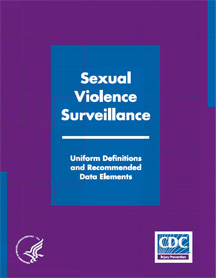 Sexual
Violence Surveillance: Uniform Definitions and Recommended Data Elements Sexual
Violence Surveillance: Uniform Definitions and Recommended Data Elements |
This report is intended for individuals and organizations interested in gathering surveillance data on sexual violence. The document is intended to promote and improve consistency of sexual violence surveillance. If the recommended data elements are uniformly recorded and the data made available to numerous users, then better estimates of the incidence and prevalence of sexual violence can be obtained. | Sexual Violence | 2002 |
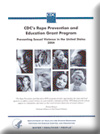 Rape Prevention and Education Grant Program: At A Glance Rape Prevention and Education Grant Program: At A Glance |
The Rape Prevention and Education (RPE) Grant Program provides more than $42 million in funding to support rape prevention activities in all 50 states, 8 territories, and the District of Columbia. | Sexual Violence | 2004 |
 Sexual Violence Prevention: Beginning the Dialogue Sexual Violence Prevention: Beginning the Dialogue |
The purpose of this document is to identify concepts and strategies that may be used as a foundation for planning, implementing, and evaluating sexual violence prevention activities. | Sexual Violence | 2004 |
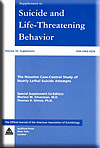 Special
Supplement to Suicide and Life-Threatening Behavior Special
Supplement to Suicide and Life-Threatening Behavior |
Employing an innovative approach to studying suicide attempters who either used a highly lethal method or would have died without medical help, CDC researchers have identified several non-traditional health risk factors that have rarely been included in suicide research. These non-traditional health associated risk factors include: acute alcohol use, changing residences, existing medical conditions, and characteristics of impulsive suicide behavior. | Suicide | 2001 |
 The Surgeon General’s Call to Action to Prevent Suicide The Surgeon General’s Call to Action to Prevent Suicide |
This document outlines more than a dozen steps that can be taken by individuals, communities, organizations, and policymakers to prevent suicide. | Suicide | 1999 |
 State
Injury Indicators Report, 2nd edition -- 1999 Data State
Injury Indicators Report, 2nd edition -- 1999 Data |
CDC's Injury Center, the Council of State and Territorial Epidemiologists, and the State and Territorial Injury Prevention Directors’ Association present the second edition of the State Injury Indicators Report (SIIR) with 1999 data. The SIIR compiles injury data voluntarily collected by 26 state health departments. It consolidates data from hospital records, death certificates, and several national surveillance systems and provides the rates of various injuries (such as traumatic brain injuries, fire and burn injuries, and suicide) and related factors (such as using seat belts and smoke alarms). Findings are also categorized by sex and age. | Injury Response | 2004 |
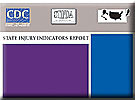 State
Injury Indicators Report State
Injury Indicators Report |
CDC’s Injury Center, the State and Territorial Injury
Prevention Directors’ Association (STIPDA), and the Council of State and Territorial
Epidemiologists have produced the first State
Injury Indicators Report. This report presents data gathered by 12
states that participated in a new program to track and monitor injuries and
related factors. It features—
|
Injury Response | 2002 |
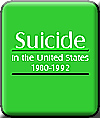 Suicide in the United States, 1980-1992 Suicide in the United States, 1980-1992 |
From 1980 to 1992, the age-adjusted suicide rate for the total U.S. population rose only slightly. Detailed analysis of the data reveals several notable trends in the age of suicide victims, the methods of suicide, and the geographic distribution of suicide cases. Suicide rates increased among persons between the ages of 10 and 19 years, among black males, and among elderly males of all races. Suicide rates for middle-aged adults declined, but the rate for Americans over age 60 increased for the first time since the late 1930s. | Violence Prevention | 1995 |
 Systematic Reviews of Strategies to Prevent Motor Vehicle Injuries, 1999 Systematic Reviews of Strategies to Prevent Motor Vehicle Injuries, 1999 |
This publication provides systematic reviews of the literature on important strategies to prevent motor vehicle injuries. It contains information on which strategies have been shown to be effective, which are ineffective, and which strategies have been inadequately evaluated that is important for both public policy and future research. | Unintentional Injury Prevention | 1999 |
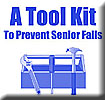 A Tool Kit to Prevent Senior Falls, 1999 A Tool Kit to Prevent Senior Falls, 1999 |
For millions of older Americans, falls present a serious health risk. In the United States, one of every three persons age 65 and older falls each year. Among older adults, falls are the leading cause of injury deaths and the most common cause of injuries and hospital admissions for trauma. | Unintentional Injury Prevention | 1999 |
 Traumatic Brain Injury in the United States: Assessing Outcomes in Children Traumatic Brain Injury in the United States: Assessing Outcomes in Children |
This report summarizes the comments, suggestions, and recommendations of a working group convened by the Centers for Disease Control and Prevention (CDC) on assessment of Traumatic Brain Injury (TBI) outcomes in children and youth. It is intended for researchers, public health professionals—including those from state health departments—and advocates interested in furthering research on outcomes of TBI in children. | Injury Response | 2001 |
 Traumatic Brain Injury in the United States: A Report to Congress, 1999 Traumatic Brain Injury in the United States: A Report to Congress, 1999 |
This Federal report summarizes current knowledge about the incidence, causes, severity, associated disabilities, and prevalence of TBI. | Injury Response | 1999 |
 Traumatic Brain Injury in the United
States: Emergency
Department Visits, Hospitalizations, and Deaths Traumatic Brain Injury in the United
States: Emergency
Department Visits, Hospitalizations, and Deaths |
This report provides detailed information about traumatic brain injury (TBI)-related deaths, hospitalizations, and emergency department (ED) visits in the United States for the years 1995 through 2001. | Injury Response | 2004 |
 Traumatic Brain Injury in the United States: The Future of
Registries and Data Systems Traumatic Brain Injury in the United States: The Future of
Registries and Data Systems
|
In 2002, CDC convened an expert panel to discuss the future of TBI registries and data systems, providing guidance for CDC to develop a national program. This report summarizes the expert panel’s recommendations, which include: funding more states to collect, analyze, and report TBI surveillance data; using existing national data sets to estimate the impact of TBI in the United States; and enhancing systems to identify and contact people with TBI and to link them with needed services. | Injury Response | 2005 |
 U.S. Fall Prevention Programs for Seniors U.S. Fall Prevention Programs for Seniors |
Selected Programs Using Home Assessment and Modification Among older adults, falls are a serious public health problem. In the United States, one of every three persons over age 65 falls each year and two-thirds of those who fall do so again within six months. |
Unintentional Injury Prevention | 2000 |
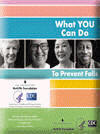 What
YOU Can Do To Prevent Falls, brochure, 2006 What
YOU Can Do To Prevent Falls, brochure, 2006 |
Falls are not just the result of getting older. Many falls can be prevented. Falls are usually caused by a number of things. By changing some of these things, you can lower your chances of falling. | Unintentional Injury Prevention | 2006 |
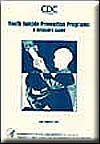 Youth Suicide Prevention Programs: A Resource Guide, 1992 Youth Suicide Prevention Programs: A Resource Guide, 1992 |
This resource guide describes the rationale and evidence for the effectiveness of various youth suicide prevention strategies and identifies model programs that incorporate these various strategies. The guide is for use by persons interested in developing or augmenting suicide prevention programs in their own communities. | Violence Prevention | 1992 |
 Youth
Violence: Facts at a Glance Youth
Violence: Facts at a Glance |
This fact sheet
provides up-to-date data and statistics on youth
violence
|
Youth Violence | 2007 |
